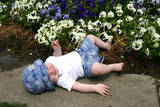Good child
Fifty years ago it wasn’t that hard to spend time with your family and children. We weren’t living in a hectic, fast and crazy world where work and errands took most of your time. But, still, there are some things you can do that will make your little ones feel loved, cherished and cared. Also, you will encourage your child’s imagination and creativity.
Camp Inside the houseChildren absolutely love camping outside, but don’t wait for spring to make them happy. Make them a tent in your living room, move away chairs from the table, and put a big blanket over it, so it reaches the floor.That will create a big camping tent, and your children will absolutely love it. You can also make small bites for snacks, and the feeling will be complete!
Don’t buy expensive toys, instead spend more time with your childKids don’t need expensive toys. Instead you need to spend more time with them, engaging them into different and fun activities. Fun way to spend time with them is to sit with them on the floor, not on the sofa, while you’re talking with them. That will make you closer to your child and it will be easier to make connection.Hide and seek is a very fun way to spend time with your child. You can also play different games, involving words and ryhmes.
In the CarWhile driving in the car, tell your little one to pay attention to trees, different colors in the nature, shapes of buildings, little animals like squirrels…Teach them to watch out for the traffic signs. That is lot of fun for them, and also educational.
Little ModelsSmaller kids love to pose for your camera. Take adventage of it and make a lot of photographs of your little ones doing different activities - while doing crafts, eating, laughing, dancing…
World OutsideSpend as much as time as you can outside. Encourage your child to notice world outside - the shapes of leaves, flowers and its colors, shapes of trees… Sounds are also important, too.
Imagination and creativityIf you give your child a plain box, you will see how it becomes a boat, a house, a colorful tree…You can make dolls from old socks, put some buttons on it and color them with different colors. You can imagine different characters, and play with your child. You will see how their imagination works. You will be amased.
What We Saw As Children
In a recent couples weekend workshop, Mary, in tears, asked, "Are we doing to our children what our parents did to us?" Although the truth hurt, the answer was: "Yes. Just as your model of marriage came from your parents, so did your model of parenting. During childhood, you took in the way you saw yourself being treated as the way to treat others; and you now refer to this early inner experience unconsciously, as your blueprint for the way to behave with your spouse and your children."
George, Mary's husband, asked somewhat fearfully, "Does that mean we have already hurt our children?" Again the answer was: "Yes. The internalization of models begins in early childhood. With their first experiences, children create a picture of the outside world. Simultaneously, in the course of interacting with their parents, they create an image of themselves. The world is 'safe' for children if their needs are met; if those needs are frustrated, the world is 'dangerous.' The corresponding image of the self is 'secure' or 'insecure,' depending on the availability of reliable warmth. So, to the extent that your conflicts have created tension in the home and diverted your attention from your child, he or she has been emotionally injured.
"During a child's first six years, the images of world and self are flexible and can be changed. Between ages 7 and 10, a child will respond to improved conditions in the environment. Once adolescence begins, however, change is more difficult because the child is well accustomed to a stressful environment and the child's behavior is more rigid. Changes in adolescence require radical alterations at home-an endeavor that may call for professional help, yet is certainly worth the effort. Why? Because whatever is not resolved in adolescence reappears in marriage and forms the basis for a power struggle."
Then came the big question: "Is there anything we can do to keep our children from having the kind of marriage that we have, or that our parents had? Can this chain of pain be broken?" The answer I gave was: "The best gift you can give your children is a good marriage."
The idea that the quality of your marriage has a direct influence on the quality of your child's future marriage may be as alarming to you as it is to couples in my weekend workshops. The fact that your relationship with your parents is the culprit in your marriage may be equally distasteful. It is certainly one of the most unwelcome ideas I have ever encountered.
Nonetheless, the evidence mounts. I have seen thousands of couples, and family researchers have studied thousands more, who are grappling with a marital conflict that can be traced back to childhood. The evidence goes even further. All our close relationships in adult life-at work, with friends, in organizations, in politics-are viewed through the screen of childhood memories. In every area of life that entails emotional involvement with others, we are repeating our childhood experiences or trying to work them out. And this struggle in adulthood to come to terms with childhood is a direct outcome of the quality of our parents' marriage, their early relationship to us, and the relationships we had with other significant people. Our children cannot escape this fate. It is a reality we must face.















0 comments:
Post a Comment